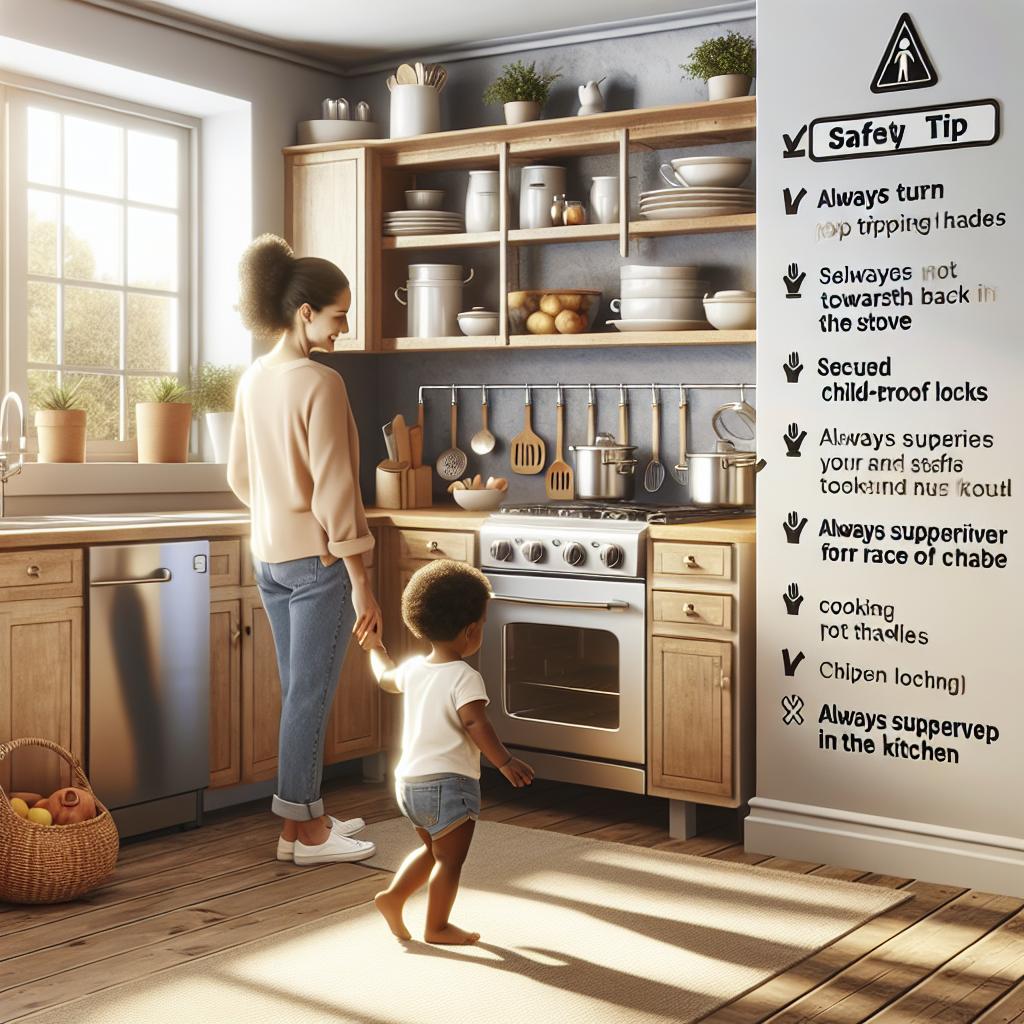Tips and Precautions for Baby Safety in the Kitchen
Understanding Why Kitchen Safety is Key
Ensuring your child’s safety is an ongoing task. As they grow and evolve, the areas of your home once deemed safe become new territories for potential dangers. One such place is your kitchen. It’s a place where family members often gather, prepare food, and share meals. But with sharp utensils, hot surfaces, and potentially hazardous appliances, it’s crucial to implement kitchen safety tips.
Child-proofing Your Kitchen: Where to Start
Initiating the process of child-proofing your kitchen requires a thorough understanding of the potential risks. Once these are identified, you can take appropriate measures to safeguard against them.
Here are some areas to focus on:
- Lower Kitchen Cabinets: Install safety locks to keep children from accessing pots, pans, cleaning supplies, or any potential hazards stored here.
- Appliances: Opt for appliances with lock features or install appliance latch straps to prevent children from opening them.
- Sharp Objects: Store knives, forks, and other sharp utensils out of your child’s reach.
Preventing Accidents: An Ounce of Prevention is Worth a Pound of Cure
While child-proofing is essential, it’s equally important to follow safety precautions to reduce the likelihood of accidents. Here are some pointers to keep in mind:
- Always supervise your child in the kitchen. No safety measure substitutes adult supervision.
- Set boundaries. Establish areas that are off-limits and consistently reinforce these rules.
- Be mindful of where you place hot pots and pans to avoid unforeseen accidents. Consider using the back burners where possible.
- Prevent potential choking hazards. Ensure your child’s food is cut into small, manageable pieces. Learn more about safe cooking and feeding practices here.
Additional Resources for Child Safety in the Kitchen
Being a parent means constantly learning and adapting. It’s a good idea to regularly check-in on safety guidelines and tips. Both Stay Safe and the CDC have excellent resources on home and food safety that could be beneficial.
Looking Beyond the Kitchen
While this article focuses on kitchen safety tips, it’s important to remember that child-proofing should extend to all areas of your home. Better Health Channel provides valuable insights into overall child safety and injury prevention.
Remember always that child safety is a journey, not a destination. With mindfulness, proper precautions, and continuous learning, you can ensure your kitchen, and indeed your entire home, is a safe haven for your child.
Essential Kitchen Safety Tips for Toddlers
You’re probably aware that toddlers are notoriously curious and love exploring new areas. The kitchen is often an area that attracts their attention due to its many sights, sounds, and smells. Thus, making your kitchen safe for curious toddlers is crucial. Adopt comprehensive safety measures tailored towards this specific age group, ensuring a safe and secure environment.
For toddlers, some of the things to focus on include:
- Stovetops: Install knob covers on your stove to prevent your little one from accidentally turning it on.
- Small Appliances: Store smaller appliances like kettles, toasters, and blenders out of reach or securely locked away.
- Dishwasher: Always lock your dishwasher when not in use. Not only does this prevent your child from accessing dirty, sharp dishes but it also keeps the detergents safely tucked away.
Take a look at the kitchen safety guide available at Nashville’s MLS, for a more comprehensive look at keeping your kitchen safe for your toddler.
Understanding Common Kitchen Hazards
Apart from physical dangers, there are plenty of other hazards in the kitchen. From chemical poisoning to food-related illnesses, ensuring your child is protected from these is integral to their safety.
- Cleaning Supplies: Always store cleaning products in a locked cabinet or high up where your child cannot access them.
- Choking Hazards: Pay careful attention to small objects such as bottle caps, plastic utensils, or even pieces of food that may pose a choking risk.
- Raw Food: Educate yourself about the dangers of food poisoning and ensure raw food is always stored properly and out of reach.
When it comes to preventing chemical poisoning, you can find helpful information on precautions and what to do in case of ingestion on Poison Help.
Building a Routine around Kitchen Safety
Building a routine around kitchen safety for your child makes it easier for them to understand the rules. Make sure you consistently use safety measures, involve them in safe kitchen activities, and always emphasize what they can and can’t do in the kitchen.
Taking it One Step Further: First Aid and CPR Knowledge
Despite all the precautions, accidents can still happen. What matters at that point, is how promptly and effectively you respond. Knowing basic First Aid procedures and CPR can make a significant difference during an emergency. Websites like Simon’s Says CPR offer courses for parents that can be incredibly beneficial and indeed life-saving.
Parting Thoughts
Ensuring baby safety in the kitchen is a task that requires constant vigilance, effort, and understanding. But remember, achieving complete safety is not instantaneous; it’s proactive and reactive measures work hand-in-hand. Countless resources, like the Basic Health and safety Guide and How to Prevent Kitchen Injuries, can provide additional information, making the journey smoother for you. With time and persistence, your kitchen can indeed become a safe space for your child to explore!
